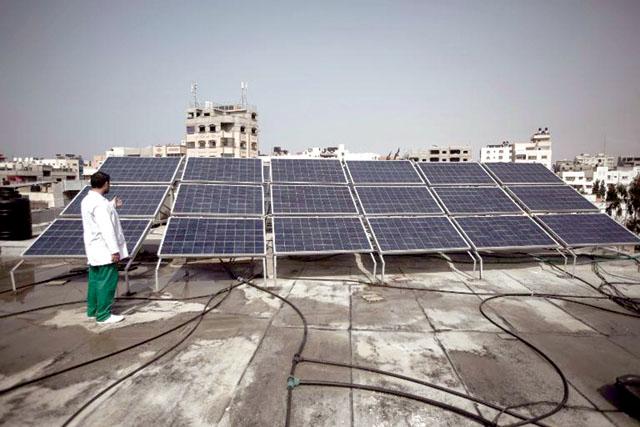You are here
Gazans turn to solar power as fuel crisis bites
By AFP - Mar 08,2014 - Last updated at Mar 08,2014

GAZA CITY — On the roof of Gaza City’s children’s hospital, a pristine row of solar panels gleams in the sunlight, an out-of-place symbol of modern, clean energy in the impoverished Strip.
As the coastal Palestinian territory lives through the worst fuel shortage in its history, many of Gaza’s 1.6 million inhabitants are beginning to see solar power not just as a viable alternative, but perhaps as the only solution to the energy crisis.
“We were forced to consider relying on solar power alone after the energy crisis that events in Egypt brought about,” said hospital director Nabil Al Burqani, referring to the closure of cross-border tunnels which halted the fuel supply into Gaza.
“We need solar energy in order to keep up care for babies in the maternity ward,” he told AFP.
“If there’s just a minute-long cut to the electricity that runs the baby incubators, a child could die.”
Gazans have learned to live with daily power outages of up to 12 hours that have affected private homes, schools, hospitals, businesses and water and sanitation plants.
The ruling Hamas movement has blamed the crisis on Egypt’s destruction of cross-border tunnels which had been used for importing fuel, a decision implemented after the military overthrew Islamist president Mohamed Morsi in July 2013.
The tunnels had played a key role in Gaza’s economy since 2006, when Israel imposed a blockade after the capture of an Israeli soldier by Palestinian militants in a cross-border raid. The restrictions were tightened the following year when Hamas seized power.
Although the Israeli restrictions have since been eased, the tunnels continued to be the main conduit for fuel.
By harnessing the energy of the intense sunlight that beats down on the coastal enclave most of the year, Gazans are optimistic they can overcome the crisis in the long term.
And initial setup costs — which include buying and installing panels and converters, and the batteries needed to run them — are potentially outweighed by the benefits.
The project at the children’s hospital, which was partly funded by British relief charity Sawaed, was set up in January 2013 at a cost of $100,000 (74,000 euros) and is now providing 20 kilowatts of electricity per day.
Elsewhere, a Kuwaiti donation of $6 million is paying for the construction of five new schools, all of which will be equipped with solar panels, the education ministry said.
But the solar drive is not limited only to large-scale foreign-funded projects.
Individual families, if they can afford the initial outlay, are also switching to solar, which promises to be a much safer alternative than generators.
After the fuel crisis kicked in, mobile back-up generators quickly became commonplace, but were often unsafe, causing a string of deaths through explosions, fires and carbon monoxide poisoning.
Shadi Jawwad bought solar panels for his home in the central Gaza Strip after getting a bank loan.
“There’s no electricity or fuel to run the generators or the power station in Gaza, but we can use the sun,” the 44-year-old government worker said.
“My own solar set-up cost 5,000 shekels [$1,400], and with it I can get enough electricity to light my home and keep the television on for several hours, even during the regular power cuts to the main supply,” Jawwad told AFP.
“This is a safe way of keeping my home running... And I only make one down payment to set up the solar power system, rather than having to buy more petrol every day for my generator at fluctuating and often extortionate prices.”
Figures released by the UN humanitarian agency OCHA show that in November, Gaza received less than 20,000 litres of fuel per week, down from nearly a million litres a day when the tunnels were operating.
Gaza’s sole power station ground to a halt on November 1 after diesel stocks ran out. It only went back online 50 days later after a delivery of Israeli fuel which was paid for by the Western-backed Palestinian Authority.
But the need to seek alternatives to carbon-based fuels appears to be sinking in.
On its website, Gaza’s energy authority says it is looking to introduce “a strategy to encourage solar energy use”, in the hope that by 2020, solar power will account for 20 per cent of the territory’s energy consumption.
For now, it is relying on a stock of solar equipment which was brought through the tunnels before Egypt shut them.
Related Articles
GAZA CITY, Palestinian Territories — Palestinians living in Gaza have long endured an unstable and costly electricity supply, so Yasser Al H
One by one, Japan is turning off the lights at the giant oil-fired power plants that propelled it to the ranks of the world's top industrialised nations. With nuclear power in the doldrums after the Fukushima disaster, it's solar energy that is becoming the alternative.
OUARZAZATE, Morocco — Morocco's King Mohammed VI unveiled one of the world's biggest solar plants on Thursday, taking advantage of the Sahar














